#Apollo Block II CSM
Text

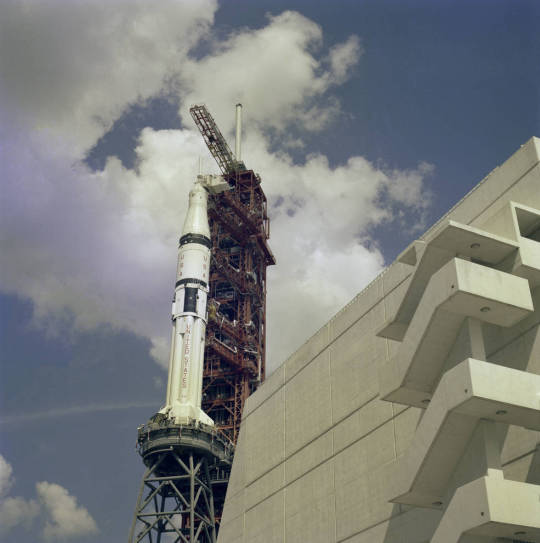
"The Saturn IB space vehicle for the Apollo-Soyuz Test Project mission, with its launch umbilical tower, rides atop a huge crawler-transporter as it moves slowly away from the Vehicle Assembly Building on its 4.24-mile journey to Pad B, Launch Complex 39, at NASA's Kennedy Space Center."
Date: March 24, 1975
NASA ID: S75-24007, S75-24009
#Apollo–Soyuz#Apollo Soyuz Test Project#ASTP#CSM-111#Apollo Block II CSM#Docking Module#Saturn IB#SA-210#Rocket#NASA#Apollo Program#Apollo Applications Program#Vertical Assembly Building#VAB#Kennedy Space Center#KSC#Florida#rollout#March#1975#my post
99 notes
·
View notes
Text
It's pretty interesting to think about how manned space capsule design, at least with the US programs, evolved so rapidly in 10 years (1958-1968).
Case in point. Mercury's only real capability, flight-wise, was to orbit the Earth. It couldn't change its trajectory mid-orbit; it had to reenter the atmosphere to do that. Gemini, however, could use vernier thrusters to change its orbit by translation and did so in March of 1965. For the uninitiated among us, verniers are gimbaled thrusters that allow you to rotate and translate a spacecraft. Gemini could even rendezvous with another spacecraft in orbit.
Apollo's CSM, obviously, was capable of far more. Gemini, in fact, was a crash program to serve as a proof of concept for technologies developed for it. But in 10 years from the first American manned spaceflight, we have Apollo Block II - which can go from the moon and back.
Truly fascinating.
1 note
·
View note
Photo

December 2... we remember Apollo 7 astronaut Don Eisele
USAF Colonel Don Fulton Eisele passed away on December 2, 1987 while on a business trip in Japan.
Selected in NASA group 3 astronauts (October 1963), Eisele was teamed up with Ed White and Gus Grissom for Apollo 1. However, Eisele flew as CMP - Command Module Pilot onboard Apollo 7 testing the first Block II CSM in LEO - Low Earth Orbit.
In 1986, Eisele was a guide onboard the supersonic Concorde passenger airliner during comet Halley’s chase flight out of Miami and New York.
Colonel Eisele was an Eagle Scout and in 1987 he was cremated in Japan, his ashes were buried in Arlington cemetery with full military honors.
(Photo: NASA)
#Ad Astra#Apollo#Astronaut#Aviator#Omega#Speedmaster#chronograph#321#861#1861#military#montres#NASA#USAF#Moonwatch#MoonwatchUniverse#Arlington#spaceflight#Moon#Mond#Lune#Maan#uhren#wristwatch#horloge#Zulu time#pilot#pilot watch#Concorde
6 notes
·
View notes
Text
Apollo-7 (lunar mission)
Apollo-7 (lunar mission)
The Apollo 7 (Moon Mission) is the first human-to-human mission in the United States Apollo series. With the exception of NASA's Gemini-12 test, this was the first test to send manned vehicles into space. The Apollo 1 manned mission in the Apollo spacecraft failed to launch a manned spacecraft into the lunar mission for 21 months after failing to catch fire in January 1967. Meanwhile, the cause of the accident was investigated and the spacecraft and security systems were improved, and the Saturn-V rocket was re-tested unmanned. The Apollo-7 test was performed by the Apollo-7 command and service module in the lower chamber of the Earth.
About the campaign ---
The commander of the Apollo 7 crew was Walter M. Schirra. The other two drivers are senior pilot Donn F. Eisele and another pilot and engineer, R. Walter Cunningham. The driver's team was tasked with maneuvering and maneuvering their spacecraft. In this way, Eisel was given the command module pilot and Cunningham the Lunar module pilot. The mission of the Apollo-C class was to test the redesign of the redesigned Block-II CSM by orbiting the Earth for 11 days. It took off from Cape Kennedy Space Station on October 11, 1968. The mission was technically a successful mission that later convinced scientists to send Apollo-8 to the lunar orbit. On October 22, 1968, the vehicle completed its test and crashed into the Atlantic Ocean.
0 notes
Photo

Fake it
This genuine NASA design makes for a stunning bright white watchband that gives the watch an unmistakable space-strap look. It's a rarely seen watchband only produced by NASA during the development stages of the Block II Apollo CSM. Though never flown in orbit, they were the current issue during manned Thermal Vacuum testing (2TV-1).
The relevant configurations of the SEB12100030 blueprint were the 19" and 21½" pairs -203 and -204 made with beta fabric tape, and then for -205 and -206 made from Telfon-coated beta cloth folded with a single seam. Five or six 1-inch segments of loop pile were stitched at regular intervals from the VELCRO® brand hook tape end.
Although the watchbands for sale here aren't made from beta fabric, the alternative fabric was chosen for the same look and feel.
https://www.seb12100030.com/products/white-nasa-velcro
0 notes
Text
Case #2: The Apollo–Soyuz Project and other space shenanigans
The Apollo–Soyuz Test Project
Apollo: Block II Apollo CSM and Apollo Docking Module / Soyuz: Soyuz 7K-TM
Thomas P. Stafford, Vance D. Brand, Donald K. Slayton, Alexey Leonov, Valeri Kubasov
Palet Cleanser: Therapy by the band Killjoy
Aftershow: We like the sound of our own voices, Oods accent, Patreon Plug
Stupid link of the episode: https://www.youtube.com/watch?v=BYJB0zyjt70
22 – Oct – 17
New Episode
0 notes
Photo

What Happened to Apollos 2 and 3? By Amy Shira Teitel October 28, 2013 Things were looking good for NASA at the beginning of 1966. The Gemini program was halfway done and well on track to accomplish all the major program goals by the end of the year, and Apollo was in the pipeline on track to begin manned missions early in 1967. And flights in support of Apollo's lunar goal were well underway by this point. Tests of the Saturn I rocket and flights of boilerplate Apollo Command Modules (CSM) had begun in 1961. And from the start NASA had been using a straightforward and self-evident naming scheme: a letter denoting the rocket and payload and number standing for the rocket type and launch number. There were ten Saturn I launches designated by “S” or “AS” followed by a number from 100 to 110. The 100-series numbers were reserved for the Saturn I rocket, so AS-101 would be the first Saturn I launch. Five Little Joe launched tests of the CSM were noted by "A" followed by a number from 1 to 4; the first was an unnumbered qualification flight. Getting closer to manned missions were the more advanced Saturn IB launches. These missions were designated “AS” for Apollo-Saturn followed by a number beginning with 201, the 200-series numbers were reserved for the Saturn IB rocket. NASA AS-109's 1965 launch. All launched in 1966 while Gemini was coming to a close, AS-201 on February 26 was a suborbital test of the Saturn IB with a Block I Apollo CSM as its payload, AS-203 on July 5 was another suborbital flight to test the CSM’s heat shield, and AS-202 was a test of the Saturn IB rocket. The next mission in the Saturn IB sequence, AS-204, was scheduled as the first manned mission. It was a simple but vital Earth orbital test of the Block I CSM scheduled to launch on February 21, 1967. When NASA received the spacecraft for AS-204, spacecraft 012, at the Kennedy Space Center on August 26, 1966, it was protected by a cover emblazoned with “Apollo One” in capital letters. The mission was colloquially known as Apollo 1; the crew even had agency approval for a mission patch paying homage to the flight’s foremost position among manned missions. Following this first manned flight would be Apollo 2 was, a duplicate of the Apollo 1 mission to give NASA a chance to test or revisit anything the first crew might have missed. Apollo 3 would debut the advanced Block II CSM, the lunar mission-capable version of the spacecraft designed to dock with the Lunar Module and create a tunnel through which astronauts could transfer between vehicles. But it wasn’t long before this plan fell out of favour. With spacecraft 014, the spacecraft for Apollo 2, falling badly behind, many started questioning the value of flying a second Block I mission. There wasn’t too much the agency could learn from a Block I flight that it could then apply to the Moon-bound Block II missions. Besides, NASA had long abandoned the practice of duplicating missions; not since Gus Grissom followed in Al Shepard’s suborbital contrails in 1961 had NASA duplicated a mission. Not long after Gemini 12 splashed down on November 15, 1966, George Mueller of the Office of Manned Spaceflight cancelled Apollo 2. The missions were reorganized so Apollo 2 would debut the Lunar Module while Apollo 3, a high Earth orbit mission with both the CSM and LM, would be the first manned Saturn V launch. This was the standing order for Apollo missions, all with assigned crews in training, in January of 1967. Then NASA was struck with its first major setback. During a pre-launch test, a fire ripped through spacecraft 012 and killed the Apollo 1 crew. The ensuing accident investigation had widespread effects. It revealed shoddy workmanship found flaws in management practices, and underscored discrepancies in the spacecraft’s overall design. The review board recommended dozens of changes be made to make the spacecraft safer going forward, meaning NASA and the CSM contractor North American Aviation were facing a substantial redesign. A congressional inquiry ended with Apollo Spacecraft Program Office manager Joe Shea leaving the agency. NASA managers became increasingly cautious right at the time they needed to take big risks to meet the end of decade lunar landing goal. The fire also forced Apollo management to reconsider whether it was worth rescheduling the Apollo 1 Block I shakedown flight at all. With so many changes pending, it hardly seemed worth flying the version of the spacecraft that wouldn’t be going to the Moon. While the Apollo 1 investigation wore on, the structure of the whole lunar program was called into question. By the end of April, the charred spacecraft 012 had been disassembled to find the root of the accident and the pieces of Apollo were slowly coming back together. The decision was made to cancel all manned Block I flights. And with the Lunar Module still behind schedule, Apollo would start with an Earth orbital Block II CSM only flight followed, possibly, by a lunar orbital CSM flight.
0 notes
Text

Workers in the VAB replace the fins on the ASTP Saturn IB’s (SA-210) first stage.
Date: March 11, 1975
NASA ID: S75-23780
#Apollo–Soyuz#Apollo Soyuz Test Project#ASTP#CSM-111#Apollo Block II CSM#Docking Module#Saturn IB#SA-210#Rocket#NASA#Apollo Program#Apollo Applications Program#stacking#Vertical Assembly Building#VAB#Kennedy Space Center#KSC#Florida#March#1975#my post
62 notes
·
View notes
Text
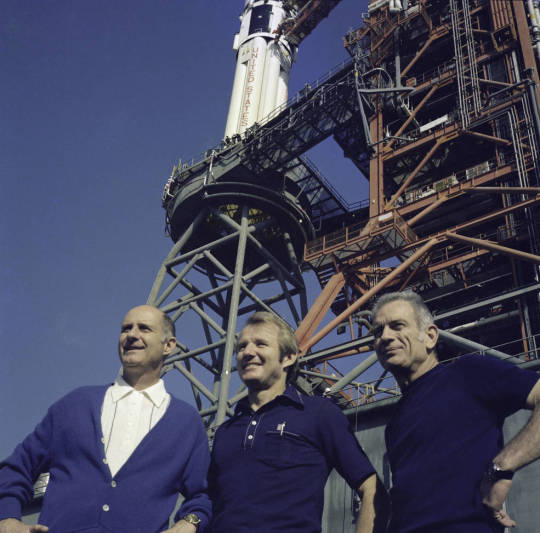
ASTP astronauts (left to right) Stafford, Brand and Slayton pose in front of their Saturn IB (CSM-111/SA-210) during the rollout.
Date: March 24, 1975
NASA ID: S75-24008
#Apollo–Soyuz#Apollo Soyuz Test Project#ASTP#CSM-111#Apollo Block II CSM#Docking Module#Saturn IB#SA-210#Rocket#NASA#Apollo Program#Apollo Applications Program#Kennedy Space Center#Florida#Rollout#March#1975#my post
49 notes
·
View notes
Text

Workers in the VAB prepare to mate the ASTP (CSM-111) spacecraft with its Saturn IB (SA-210) rocket.
Date: March 18, 1975
NASA ID: S75-24424
#Apollo–Soyuz#Apollo Soyuz Test Project#ASTP#CSM-111#Apollo Block II CSM#Docking Module#Saturn IB#SA-210#Rocket#NASA#Apollo Program#Apollo Applications Program#Vertical Assembly Building#VAB#Kennedy Space Center#KSC#Florida#Stacking#March#1975#my post
25 notes
·
View notes
Text
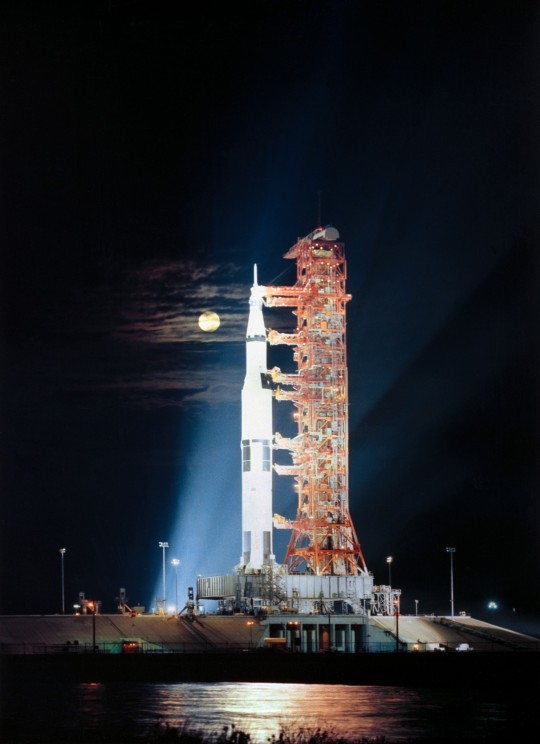

"Searchlights illuminate this nighttime scene at Pad A, Launch Complex 39, Kennedy Space Center, Florida, showing the Apollo 17 (Spacecraft 114/Lunar Module 12/Saturn 512) space vehicle during prelaunch preparations. Apollo 17, the final lunar landing mission in NASA's Apollo program, will be the first nighttime liftoff of the huge Saturn V launch vehicle. Apollo 17 is scheduled for launching on the night of Dec. 6, 1972. Aboard the Apollo 17 spacecraft will be astronaut Eugene A. Cernan, commander; astronaut Ronald E. Evans, command module pilot; and scientist-astronaut Harrison H. Schmitt, lunar module pilot. Note the full moon in the background."
Date: November 1972
NASA ID: S72-54813, 7004739, 72-H-1455, 72-HC-847, 72-H-1454
#Apollo 17#CSM-114#America#Apollo Block II CSM#Lunar Module#LM-12#Challenger#Saturn V#SA-512#Rocket#NASA#Apollo Program#J-type mission#LC-39A#Kennedy Space Center#Florida#Moon#November#1972#my post
33 notes
·
View notes
Text
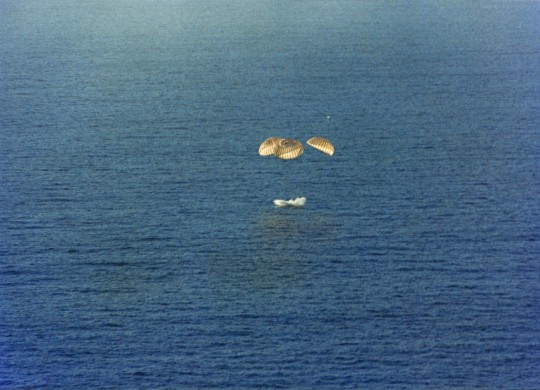
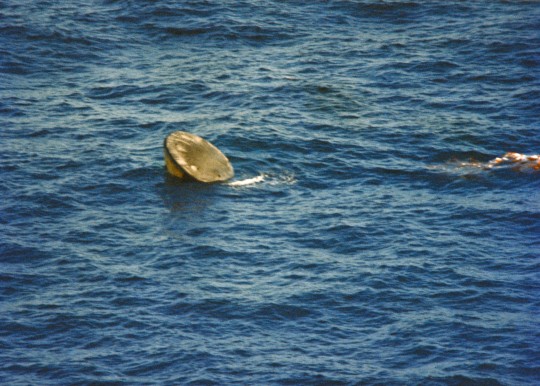
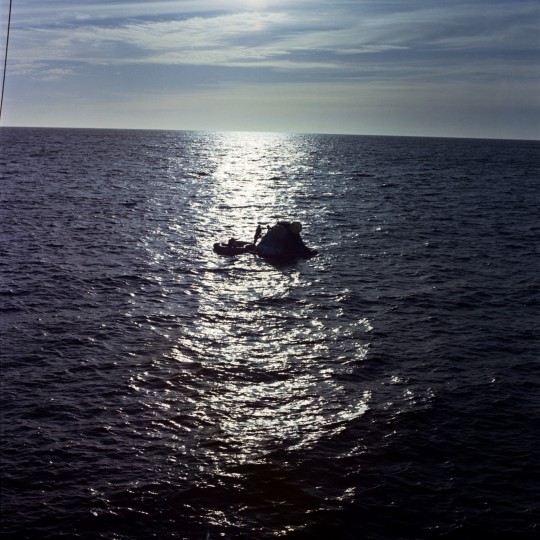
"The Skylab 4 Command Module splashes down in the Pacific Ocean southwest of San Diego, California at 10:17 am. The Command Module bobs in an apex-down configuration (stable two) in the calm water of the Pacific Ocean 176 miles southwest of San Diego, California, following a successful splashdown and 84-day mission in Earth orbit."
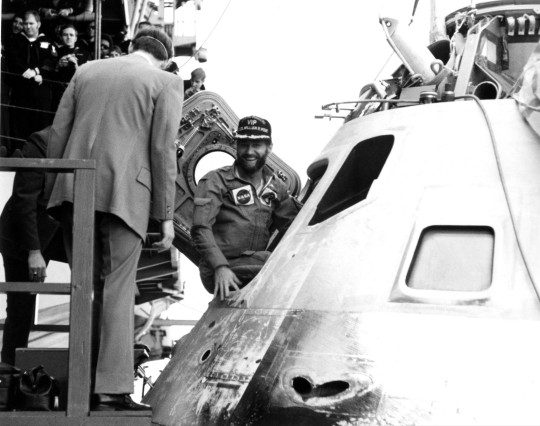
"A smiling William R. Pogue pauses in hatchway of Skylab 4 command module during recovery activities today aboard the USS New Orleans at the completion of man's longest space journey to date. Pogue splashed down with astronauts Gerald P. Carr and Dr. Edward G. Gibson, 84 days after the trio was launched by a Saturn IB rocket from Kennedy Space Center. Circling the globe 1, 214 times aboard the sophisticated Skylab space station during the nearly three-month flight, the astronauts demonstrated man's ability to live and work in space for extended periods."
Date: February 8, 1974
NASA ID: S74-17741, S74-17742, S74-17133, KSC-74PC-32
#Skylab IV#Skylab 4#SL-4#SLM-3#CSM-118#Apollo Block II CSM#NASA#Apollo Program#Apollo Applications Program#Splash Down#Splashdown#Recovery#USS New Orleans (LPH-11)#USS New Orleans#Iwo Jima Class#Amphibious Assault Ship#Pacific Ocean#February#1974#United States Navy#US#Navy#USN#my post
25 notes
·
View notes
Text

Apollo 8 Coming Home
"Human eyes directly observed the far side of the Moon for the first time on Christmas Eve 1968. Robert McCall imagines the sight of the rocket engine firing to propel the spacecraft out of lunar orbit for its return to Earth."
Artist: Robert T. McCall
NASA ID: link
#Apollo 8#CSM-103#Apollo Block II CSM#NASA#Apollo Program#C Prime-type mission#concept art#moon#space#December#1968#my post
28 notes
·
View notes
Text

North American Rockwell concept art of the Apollo 8 mission.
Date: December 2, 1968
NASA ID: S68-51302
#Apollo 8#CSM-103#Apollo Block II CSM#NASA#Apollo Program#C Prime-type mission#concept art#Moon#Space#December#1968#my post
26 notes
·
View notes
Text


"The first stage (S-IC) of the Apollo 10 Saturn V (SA-505) space vehicle is hoisted above the transfer aisle in preparation for erection on a mobile launcher within High Bay 2 of the Vehicle Assembly Building (VAB). The erection of the 138-foot-long stage marked the first use of mobile launcher 3 and high bay 2. Apollo 10 will be piloted by astronauts Thomas Stafford, John Young and Eugene Cernan. In the foreground are the mated command, service and lunar modules, the latter enclosed within the adapter, for the Apollo 9 (CSM-104/LM-3) flight of James McDivitt, David Scott and Russel Schweickart."
Date: December 5, 1968
NASA ID: S69-15690, KSC-68P-0575
#Apollo 10#SA-505#F-type mission#S-IC#Apollo 9#CSM-104#Gumdrop#Apollo Block II CSM#Lunar Module#LM-3#Spider#Saturn V#Rocket#NASA#Apollo Program#D-type mission#Vertical Assembly Building#VAB#Kennedy Space Center#KSC#Florida#December#1968#my post
21 notes
·
View notes
Text

Workers lower the ASTP CSM-111 onto the SLA.
Date: March 3, 1975
NASA ID: 75-H-191A
#Apollo–Soyuz#Apollo Soyuz Test Project#ASTP#CSM-111#Apollo Block II CSM#Docking Module#Manned Spacecraft Operations Building#MSOB#Kennedy Space Center#KSC#Florida#stacking#March#1975#my post
16 notes
·
View notes